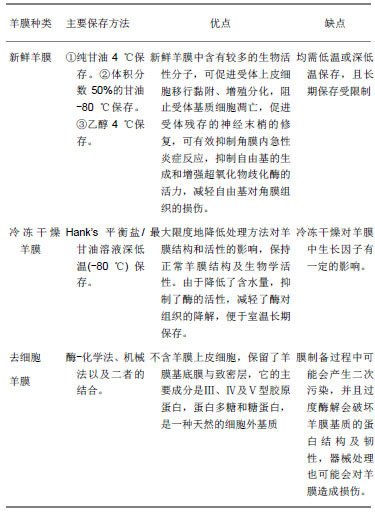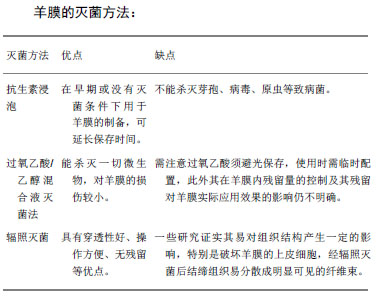| [1]John T,John OC.Ultrastructural characteristics of four types of human amniotic membranes. Invest Ophthalmol Vis Sci.2000; 42: S271.[2]Mamede AC,Carvalho MJ,Abrantes AM,et al. Amniotic membrane: from structure and functions to clinical applications. Cell Tissue Res.2012;349(2): 447-458.[3]Loeffelbein DJ,Baumann C,Stoeckelhuber M,et al.Amniotic membrane as part of a skin substitute for full-thickness wounds: an experimental evaluation in a porcine model. J Biomed Mater Res B Appl Biomater.2012;100(5): 1245-1256.[4]Füst A,Pállinger E,Stündl A,et al. Both freshly prepared and frozen-stored amniotic membrane cells express the complement inhibitor CD59. Scientific World J.2012;2012:815615. [5]Liu T,Zhai H,Xu Y,et al. Amniotic membrane traps and induces apoptosis of inflammatory cells in ocular surface chemical burn. Mol Vis.2012;18:2137-2146.[6]Alsina-Gibert M,Pedregosa-Fausteb S.Amniotic Membrane Transplantation in the Treatment of Chronic Lower Limb Ulcers. Actas Dermosifiliogr.2012;103(7): 608-613.[7]Sharma Y,Maria A,Kaur P.Effectiveness of human amnion as a graft material in lower anterior ridge vestibuloplasty: a clinical study. J Maxillofac Oral Surg.2011;10(4):283-287. [8]Amensag S,McFetridge PS.Rolling the human amnion to engineer laminated vascular tissues. Tissue Eng Part C Methods.2012;18(11):903-912. [9]Hao YX,Ma DH,Hwang DG,et al.Identification of antiangiogenic and antiinflammatory proteins in human amniotic membrane.Cornea.2000; 19(3):348-352.[10]Uberti MG,Lufkin AE,Pierpont YN,et al.Amnion-derived cellular cytokine solution promotes macrophage activity. Ann Plast Surg.2011;66(5):575-580.[11]Uberti MG,Pierpont YN,Ko F,et al. Amnion-derived cellular cytokine solution (ACCS) promotes migration of keratinocytes and fibroblasts. Ann Plast Surg. 2010;64(5):632-635.[12]Steed DL,Trumpower C,Duffy D,et al.Amnion-derived cellular cytokine solution: a physiological combination of cytokines for wound healing. Eplasty.2008;8:e18.[13]Franz MG,Payne WG,Xing L,et al.The use of amnion-derived cellular cytokine solution to improve healing in acute and chronic wound models. Eplasty. 2008;8:e21.[14]华萍,赵淑娥,赵集,等. 体内植入羊膜的免疫安全性观察[J].南昌大学学报:医学版,2010,50(9):11-17.[15]张琪, 赵敏,胡柯,等.新鲜和保存羊膜移植后外周血T细胞变化及免疫病理学研究[J].中国病理生理杂,2008,24(12):2460-2464.[16]张琪, 赵敏, 胡柯,等.异源性新鲜和保存羊膜移植后免疫相容性及组织学转归的比较研究[J].中国修复重建外科杂志,2008,22(5):619-624.[17]华萍,华东,赵集帅,等.不同保存方法对羊膜生物学性能影响的比较研究[J].南昌大学学报:医学版,2010,50(11):6-12.[18]滕丹,栾新尧,许妮娜,等.辐照灭菌冷冻干燥羊膜修复碱烧伤[J].中国组织工程研究与临床康复,2011,15(44):8325-8328.[19]华萍,涂桂林,余万霰,等.冷冻干燥对羊膜组织形态与生物活性因子的影响[J].南昌大学学报,2010,50(4):43-46.[20]雷宁静,胡炜,王成春,等.两种羊膜脱细胞基质制备方法的比较[J].郑州大学学报,2010,45(4):572-575.[21]柯宁,赵敏,李臻,等. 胶联羊膜的制备及生物力学研究[J].中国生物医学工程学报,2008,27(1):112-116.[22]蔡明铭,赵 敏.更昔洛韦-纤维蛋白胶-羊膜复合物的缓释特[J].中国组织工程研究与临床康复,2011,15(3):419-422.[23]Resch MD,Resch BE,Csizmazia E,et al. Drug reservoir function of human amniotic membrane.J Ocul Pharmacol Ther.2011;27(4):323-326.[24]郭华,徐国士,王波涛,等.有孔牛羊膜联合重组牛碱性成纤维细胞生长因子覆盖II度烧伤创面:与无孔牛羊膜及凡士林纱布的比较[J].中国组织工程与临床康复,2009,13(51):10193-10196.[25]周文君,赵敏,牟彦. 载表皮生长因子/壳聚糖纳米粒纤维蛋白胶胶联羊膜的制备及体外释药评价[J].中国组织工程研究与临床康复,2011,15(34):6322-6325.[26]杨雨昆,赵敏.不同灭菌方式与羊膜上皮细胞活性:以组织形态及肝细胞生长因子和金属蛋白酶组织抑制剂1为标准的评价[J].中国组织工程研究与临床康复,2010,14(33):6151-6154.[27]Versen-Hoynck F,Syring C,Bachmann S,et al.The influence of different preservation and sterilisation steps on the histological properties of amnion allografts – light and scanning electron microscopic studies. Cell Tissue Bank.2004; 5(1):45-56.[28]Pruss A,Baumann B,Seibold M,et al.Validation of the sterilisation procedure of allogeneic avital bone transplants using peracetic acid-ethanol. Biologicals.2001;29(2): 59-66. |

